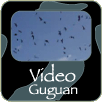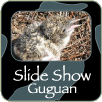

| the expedition | |
| the science | |
| tools & techniques | |
| marianas history | |
| daily journal | |
| the team | |
| questions & answers | |
|
the islands Saipan Anatahan Sarigan Guguan Alamagan Pagan Agrigan Asuncion Maug Uracas |
|
|||||||||||||||||||||||||||||||||||||||||||||||||||||||||||||||
Daily Journal
Day 18 | April 26, 2004
Guguan
Allan Sauter's Log

Guguan is a very special island that was set aside as a natural preserve by the Commonwealth of the Northern Mariana Islands (CNMI) in the early '80s. Unlike most of the CNMI islands, it has never been settled by humans, goats, or pigs, leaving the the native bird population undisturbed. To go ashore, it was necessary to get permission from the Department of Fisheries and Wildlife to disassemble our seismic station that was put in last year. When we landed, countless Sooty Terns flew up from their nests and voiced alarm. We had to carefully watch our step to keep from breaking the speckled eggs or trampling newborn chicks as we slowly made our way the 300 meters to our seismic station. We've arrived at the very height of the breeding season and are reminded of Hitchcock's movie: The Birds. Hajime Shiobara's movie shows their abundance.
Yesterday (Thursday), Alison and I were completely worn out climbing up a steep ravine on eastern Guguan following Toby, where he sampled olivines while Red-footed Boobies watched from a nearby tree. Today, when we finished taking down our station, 3 of us decided to climb to the summit. After quite a lot of puffing (we haven't built up the stamina of those buff volcanologists yet) we made it to the top. Along the way we saw a very rare Micronesian Megapode bird underneath a Lada tree. This tree is used by the islanders as a cure for diabetes. Near the top I was admiring a big volcanic rock all covered with dry lichen and noticed a pair of Red-tailed tropic birds resting underneath. Joe Kaipat, shown in the slide-show surrounded by terns, told us that the tropic birds fish by skimming over the ocean, dipping their tail in the water to lure small fish. When one goes to bite, the bird twists around and has the fish for lunch. At the top of Mount Guguan, there were 4 splendid Red-footed boobies - kings of the mountain. They didn't receive enough human visitors to make them fly away, so we shared the top with them and ate lunch. After we got back to the shore, I got a chance to snorkel at the tabular basalt rock where we landed and to take a few underwater shots.
It is a very refreshing privilege to be able to see this unique island. The more places I've visited, the more I have grown to appreciate the world's natural beauty and variety. William Ritter, SIO's founder, said that all men should be naturalists. I agree, and so I've created a web game: FishNtheSea where we can all share our pictures of the natural world and zoom around maps to explore what's to be found there. I'm hoping you'll take his advice and play this game with me. The web address is:http://www.mpl.ucsd.edu/people/sauter/fishnthesea/world.htm I'm looking forward to adding pictures that our expedition members have taken on this trip when we get back home.


